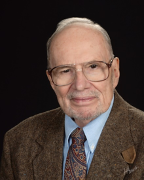
Emerit professor of physics Paul Quin passed away on October 9, 2025. He was 84.
Born in Brooklyn, NY in 1941, Quin received his doctorate in physics from the University of Notre Dame, where his thesis work centered on the spectroscopy of the SD-shell nuclei. He joined the nuclear physics group at UW–Madison as a postdoc in 1969, playing a central role in the construction and installation of the new Lamb-Shift polarized ion source. He was also one of three survivors of the 1970 Sterling Hall bombing.
Quin joined the faculty in 1971. His research focused on the use of polarized beams as a tool for nuclear spectroscopy and his group made numerous important contributions in this field. In addition, Quin was an important player in the many instrumentation development projects that took place in the nuclear physics lab during the 1970s and the early 80s. In particular, he was the leader of the first experiment to test storage-cell technology for targets of polarized hydrogen atoms, a technology which has gone on to become important for polarization experiments at storage ring machines throughout the world.
Around 1980, Quin began expanding his research focus, moving into the field of weak interactions. In the years that followed, he carried out a variety of interesting and important experiments on β decay of polarized nuclei. These experiments typically involved tests of the conserved-vector-current hypothesis or searches for right-handed currents. In 1986, he and T. Girard published an important paper which described a new and potentially very sensitive technique for detecting right-handed currents in β decay. This new concept, which involves measuring the polarized-nucleus beta asymmetry correlation, became the basis for a number of experiments performed over the subsequent decade in both the U.S. and Europe, with Quin playing a central role in many cases.
Later in his career, Quin continued to work in the area of weak interactions, helping to define the role of various nuclear physics experiments that place constraints on extensions of the standard model. Quin retired in 2001.
Quin also made many contributions to the teaching mission of the department. His great enthusiasm for teaching was always evident, and he frequently introduced new and innovative ideas in the classes he taught. In the ‘80s, he took responsibility for developing new experiments for the Physics 321 lab and upgraded a number of the existing experiments. Towards the end of his teaching career, he was a tireless instructor in the large introductory courses, contributing in a number of important ways to the implementation of computer-based laboratories. In addition, Quin was a staunch supporter of the department’s then-new Peer Mentor Tutor Program. He also supervised nine students who received doctorates under his guidance.
In retirement Paul was an active participant in many feeding projects for those in need. He was instrumental in securing volunteers and food for the Men’s Shelter, The Adopt-a-School program and the Allied Community. In addition he was a long time volunteer for Meals on Wheels. After moving to Maryland to be nearer to his daughter and her family, he was a proud grandparent who enjoyed being with his two grandchildren.
This post was mostly derived from department archives